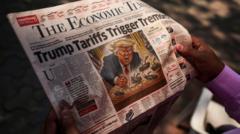India, the world's fifth-largest economy, may benefit from its self-reliant approach during a global tariff-driven slowdown, but experts stress the need for gradual trade liberalization and strategic reforms to seize future opportunities.
India’s Trade Strategy: A Path to Resilience Amid Global Tensions

India’s Trade Strategy: A Path to Resilience Amid Global Tensions
As the global economy faces increasing protectionism, India’s inward-focused trade policies may provide it with an unexpected advantage.
India's position as the world’s fifth-largest and one of its fastest-growing economies presents a unique narrative in light of escalating international trade tensions. Traditionally marked by protectionism and inward-looking trade policies, India’s relatively low integration into the global market, with exports making up less than 2% of the worldwide total, may paradoxically serve as a buffer against the turmoil that more trade-dependent nations face.
As the United States alters its trade dynamics under new tariff frameworks—highlighted by former president Donald Trump’s temporary tariff respite—India's moderate engagement in global commerce could allow it to navigate these disruptions more effectively than its export-driven counterparts. Rajeswari Sengupta, an economic expert at the Indira Gandhi Institute of Development Research, notes, “If export-reliant nations suffer from tariff constraints while India maintains a growth trajectory, we could emerge comparatively strengthened due to our robust domestic market.”
However, this protectionist posture comes not without its cautions. While India’s insulated trade stance might afford it short-term resilience, experts emphasize the pressing need for a strategic shift toward gradual trade openness to harness evolving market opportunities. The nation’s intricate history with trade policies, marked by high tariffs and a preference for self-sufficiency, complicates this transition.
Historical accounts illustrate that India’s insularity deepened post-World War II, where industries secured extensive protection leading to stagnant exports and a beleaguered economy. While a pivotal economic liberalization in the early 1990s spurred growth—resulting in a sixfold increase in exports within a decade—the recent resurgence of protectionist measures threatens to undermine these gains.
Arvind Panagariya, a renowned trade economist, points out how the rollback of liberalization since 2018 has stifled initiatives like “Make in India,” which emphasized modernizing manufacturing capabilities. The imposition of tariffs has often led to dominance from established firms, creating a cycle of inefficiency rather than competitive advantage.
As international alignments shift, particularly with the EU seeking reliable trading partners amid the US and Chinese uncertainties, India stands at a crossroads. Economists advocate for reducing tariffs and enhancing export capabilities to tap into burgeoning markets, especially sectors like textiles and garments, to offset potential losses from recent US tariffs—the projected drop could be upwards of $7.76 billion in 2024.
To realize this vision, India must not only pursue trade agreements with Western economies but also foster deep-rooted connections with diverse markets, including China and ASEAN nations. Domestically, critical reforms to streamline the Goods and Services Tax, reduce tariff complexity, and enforce quality standards are fundamental for India to seize this juncture effectively. Without concerted efforts to modernize its trade framework, the country risks missing out on global economic momentum.





















